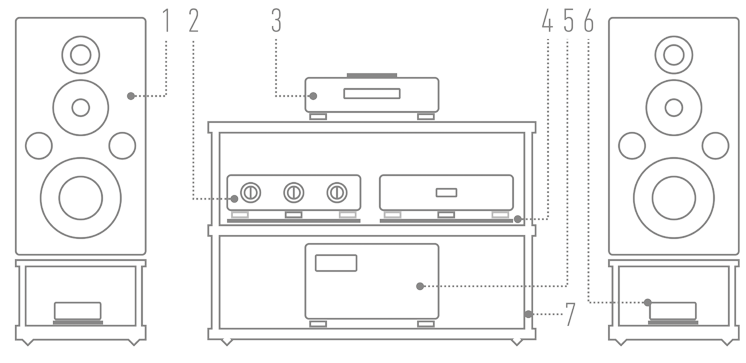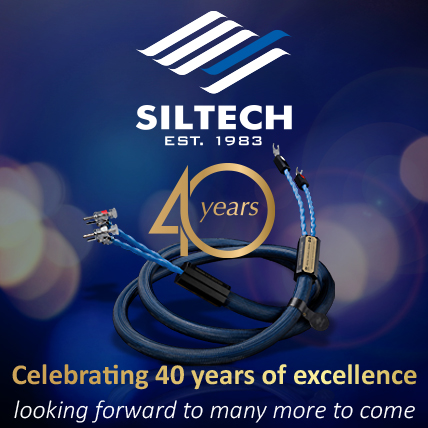|
POWER DISTRIBUTOR AC ACOUSTIC REVIVE
Manufacturer: SEKIGUCHI MACHINE CO., Ltd. |

|
Review
text by WOJCIECH PACUŁA |

|
No 258 November 1, 2025 |
|
˻ PREMIERE ˼ ⌈ ACOUSTIC REVIVE is a Japanese company founded in 1997 and run by Mr. KEN ISHIGURO. It specializes in connection cables and anti-vibration products, but also offers innovative products, most of which are based on ideas developed by the University of Tokyo. We are testing the latest AC power strip, RTP-4EU Final. This is its world premiere. ⌋ ONE OF THE CONSTANTS in the ever-changing “High Fidelity” listening system – I am thinking of the devices we test – are the reference components. They serve as a benchmark for all other devices we test and allow us to evaluate them as objectively as possible. It is not even about them being the best in the world, but about them being good enough so that all the differences between the devices, speakers, cables, and accessories we test and publish are clear and can be described in a way that will be helpful to you. 
This strategy has proven itself perfectly in the more than twenty-year history of High Fidelity. That's why I don't mention products in the reference system too often – to be honest, I do it very rarely, and only when it makes deep sense in the context of comparisons. But that's not all. Since I spend many hours listening to music with this system, a new product must also move me, reach me personally, for me to decide that “yes, it's high time...” It is no different with the AC power strip from Acoustic Revive. The first version I listened to → RTP-4EU ULTIMATE ˻PL˺, was its second development version, after RTP-4 (RTP is an acronym for Reduced Transmission Path, a technology used to minimize interference in the AC power grid). I liked the simplicity of its design, which resulted from its excellent mechanical construction and well-thought-out selection of components. However, the choices and solutions characteristic only of this manufacturer were equally important to me. At the time, they seemed “cosmic” and over-complicated, but today we can find them in many other products made around the world. Ken Ishiguro, the head of Acoustic Revive, has a sixth sense that allows him to convert a combination of technical knowledge, experience in high technology, and sensitivity to changes in sound. That is why, every few years, he offers new versions of his products, which I regularly replace, including the power strip. After the first one in our history, with the ‘Ultimate’ suffix, which we tested in 2010, eight years later it was time for the → RTP-4EU ABSOLUTE version, which replaced the previous one in our system, and this year we are getting a power strip with the telling name Final. RTP has been part of the HIGH FIDELITY system for fifteen years, and it looks like the “twenties” are just around the corner. ▌ RTP-4EU Final The design of the RTP power strip intended for sale outside Japan remains unchanged: it is a solid cuboid made of a solid aluminum block with an aluminum plate screwed on top. It is an AC power strip with four Schuko sockets (versions with six sockets are also available in Japan), measuring 880 x 700 x 265 mm and weighing approximately 4 kilograms. The basis of the strip are the sockets. This is a product from another Japanese company, Furutech, belonging to the NFC series. The transition from the Ultimate to the Absolute version in 2018 mainly involved replacing the company's older sockets with new ones featuring Nano Crystal2 Formula (NFC) technology. Although this material is already nine years old – it was first used in 2016 – and although, apart from AC power sockets, where it was used, it has expanded to a whole range of products, including line plugs, boosters, etc., it is still the company's most important innovation. 
Let us remind you that this is a material that has “active” properties. Firstly, it generates negative ions, which eliminate static electricity in the socket, and secondly, it converts thermal energy into easily extinguishable infrared waves. This material has been combined by Furutech with nanoceramic particles and carbon powder, which have piezoelectric properties. Both the Schuko FI-50 NFC sockets and the IEC FI-09 NCF socket feature contacts made of pure copper that has been heat-treated using the company's α (Alpha) process and rhodium-plated. It is interesting to note that NFC is an idea that originated with Acoustic Revive and was implemented thanks to Furutech's resources and contacts. And although today we associate it with the latter manufacturer, it is a joint effort. The use of sockets made of this type of material in the RTP-4EU Absolute power strip was therefore a natural change from the Ultimate version. In the latest Final power strip, the sockets have remained the same, and the changes concern something else. The timeline for the RTP series is as follows: » 1999: RTP-6 – Furutech rhodium-plated Schuko and IEC sockets, OFC wiring with insulation, » 2000: RTP-4 – specification same as above, four sockets, » 2004: RTP-6 & 4 Evolution - Rhodium-plated Schuko Oyaide sockets with cryogenic treatment, rhodium-plated IEC Furutech socket with screw terminals, PCOCC-A internal wiring with PE insulation, » 2009: RTP-6, 4, 2 & 4EU Ultimate – Oyaide Schuko sockets with rhodium-plated beryllium copper contacts, cryogenically treated, PCOCC-A internal wiring in PE insulation, rhodium-plated Furutech IEC socket with screw terminals, » 2014: RTP-6, 4, 2 & 4EU Absolute – Furutech Schuko sockets made of rhodium-plated pure copper, NCF resin and cryogenic treatment, internal wiring made of PC-TripleC with silk insulation, rhodium-plated Furutech NCF IEC socket » 2024: RTP-6, 4, 2 & 4EU Final – same specifications as Absolute, but with the addition of powdered tourmaline and powdered Kiyoh stone, as well as a high-frequency noise reduction system All models have the following features in common: ▲ A few simple words… KEN ISHIGURO THE NEW FINAL STRIP is based on developments that we first implemented in the Ultimate model and then in the Absolute model. Each time, the changes are the result of listening sessions and measurements and are based on specific solutions, often previously tested in other products. The Final model features an integrated noise reduction circuit previously introduced by us in the CS-3K filter (tested → HERE – ed.). Although the CS-3K removes high-frequency noise from the power line, in the RTP-Final this circuit works not only on the power line, but also on the ground line. 
The method of noise reduction inside the enclosure has also been improved. The previous RTP series had a casing made of A2017 aircraft-grade aluminum alloy, with green carborundum and elbaite (tourmaline) powder embedded in resin at the bottom. In the new RTP-Final, we have added Kiyoh mineral (a rare ore whose main component is aluminum silicate) and several other types of ore powder, increasing their effectiveness against noise and electrostatic charges. 
We have also improved vibration damping by replacing the feet with new ones. The feet in the previous model were made of chrome-plated, machined brass with a vibration-damping sheet underneath. The new feet are still made of machined brass, but now they are gold-plated and feature an impregnated RKI-1803 silicone insulator glued underneath (this is a small type of RKI-5005 pads, test → HERE – ed.). These pads also contain powdered Kiyoh stone. RTP-Final improves the signal-to-noise ratio over a very wide frequency range, without any energy loss or negative impact on the sound. » KI AS YOU CAN SEE, THE CHANGES compared to the Absolute version are not minor. The strip looks almost identical, except for the “blinky” gold feet underneath and the color of the top plate. In Ultimate it was black, in Absolute it was silver, and in Final it is titanium. The sockets are connected internally with the same solid-core (single wire) cable as before. It is an oval PC-tripleC 2.8 x 2.4 mm cable with silk-Teflon insulation, manufactured by Furukawa for Acoustic Revive. The material called PC Triple-C, or Pure Copper-Continuous Crystal Construction, is obtained in a process similar to forging, in which the wire is struck repeatedly. The blows are applied at a specific angle and direction, selected as a result of experiments.As a result of this treatment, the wire's volume is reduced by 70%. 
Although this material does not have a particularly high purity expressed in “N” (6N, 7N, etc.), in reality the barriers between crystals are very low. Mr. Ishiguro even says that the transitions are less visible than in the best copper invented to date, namely PCOOC-A (Pure Copper Ohno Continuous Cast Advanced). Triple-C copper is produced in small quantities by a separate division of the Furukawa Group, Fine Chemicals & Materials (FCM). |
All internal components have been coated with Kiyoh-stone, a paint that minimizes electrostatic charges. The property of this material that Mr. Ishiguro-san was interested in is that, when vibrated, it easily generates high-intensity negative ions, which peak in the far-infrared range. Kiyoh-stone generates up to 40 times more ions than tourmaline. Underneath the strip and on the IEC socket, on the inside, QR-8, small tablets made of natural dark crystal, were placed. The power strip looks great, professional, solid yet modest. ▌ SOUND HOW WE LISTENED• The test consisted of comparing the Acoustic Revive RTP-4EU Final power strip to a reference system consisting of a power strip Acoustic Revive RTP-4EU Absolute, in both cases with a 2.5 m long Acrolink Mexcel 7N-PC9500 power cable and a passive Acoustic Revive RAS-14 Triple-C filter. The power cable was plugged into a Furutech FT-SWS (R) wall socket, followed by a separate power line featuring Oyaide Tunami cable, and a separate AHP Klangmodul III fuse. 
During the comparisons, I switched the entire power supply to the system. Since it takes time for the tubes in the SACD player and preamplifier to warm up again, two minutes had to pass between each series of comparisons. The comparison was run is a AA/BB/A BB/AA/B sequence, with A and B known. » RECORDINGS USED FOR THE TEST ⸜ a selection
⸜ BILLIE HOLIDAY, Body and Soul, Verve Records/Mobile Fidelity Sound Lab UDCD 658, series „Original Master Recording, Ultradisc II”, Gold -CD ⸜ 1957/?. YOU DON'T HAVE TO SIT IN FRONT OF THE SYSTEM for hours to catch the differences between the Absolute and Final strips. In fact, you don't have to sit at all, because they are clear from the very first moment, they are downright imposing. But – and this is key – they don't impose anything on their own, because the sound from the RTP-4EU Final in the system is more refined and at the same time less attention-grabbing in terms of technology than in the two previous power strips from this manufacturer, which I have been listening to music with for the last fifteen years. 
Over the past seven years, since we are talking about the calendar, during which the Absolute power strip has been part of my reference system, I have compared many power strips and conditioners to it. These comparisons always revealed one thing: it is a product with an extremely natural, almost dark sound. But not dark because of the high frequencies being cut or rolled off, but because of the deepening of the background – yes, this is the case we are referring to when we talk about a “black background.” Let us remind you that we are talking about the absence or very low level of noise and other interference in the sound signal that is audible during silence or when playing quiet music. And it is an element that immediately “comes to life” before our eyes. So when I played ˻ 2 ˺ They Can’t Take That Away From Me, the second track on BILLIE HOLIDAY's album Body and Soul, my attention immediately focused on this element – the background from Final is even darker, even smoother, even more velvety. Although this may seem insignificant for the sound itself, in reality, for audio systems, well-matched systems – regardless of price range – this is a key change. This is because not only Berney Kessel's guitar, warm by nature, especially with the reverb that was added to it, but also Holiday's vocals, quite bright, at times almost too bright, sounded more natural, more intimate. When in ˻ 3 ˺ Darn That Dream, she sings “Darn that dream and bless it too / Without that dream I never would have you,” with the new strip, it's somehow easier to believe. This change is significant enough to shift the emphasis or a center of gravity of both the tone and dynamics of the reproduced tracks. It may not seem like much, and it may not be as dramatic as replacing the amplifier. But on the other hand, this shift is even more important, because it does not “simply” change the sound, but gives a better picture of it, showing a better version. A nicer, more pleasant one. In a way, it is better “tailored” to a given recording, a given album. It's as if we were looking at something from an angle and then saw it right in front of us. Final plays music in a more organized way, although the last thing we would say about Absolute, or – earlier – Ultimate, is that they play in a disorganized way. And yet, in a moment, we know that with Final, Ken Ishiguro has managed to take another step forward. It may seem small, from the point of view of cheaper systems it will be a small step, but in high-end it may turn out to be a giant leap. One that will allow us to fly over valleys, and obstacles. Therefore, when the latest Acoustic Revive power strip is included in the system, even more albums will sound in an engaging way. It does something to the sound that makes it more resolving, but also more pleasant. I mentioned Billie Holiday at the beginning because her vocals are recorded in a very open way. When pressing an LP, this was often smoothed out, either due to the imperfection of the copy or by deliberate action. However, when the tape is recorded “flat,” without corrections, it can sound too bright. With the Final strip, you can hear what kind of microphone we are talking about, and yet it is not unpleasant. It is as if there was an internal “arrangement” on the sound along the way, without any obvious correction. The album recorded thirty-nine years later, ANNIE LENNOX's Medusa, sounded very similar. I have several versions of it, the most interesting of which is the one released in 2014 by Sony Music in Hong Kong. It was remastered in the K2HD system and released in a limited, numbered edition. 
But even this one sounds quite bright and not entirely saturated. We play it with the new Acoustic Revive strip and get the same result: an open sound with lots of high frequencies. But there is also a subtle change that makes us listen to it differently, comfortably. It's about cleaning up the upper part of the range from a slight nervousness that I didn't know was there before. Music presented in this way flows in a slightly lazier way on the one hand, and in a more energetic way on the other. This suppression of nervousness will be repeated on every subsequent album, whether it be ISAO SUZUKI QUARTET's Blue City, ART BLAKEY's Moanin’, or even SANTANA's Supernatural. On the Three Blind Mice’s release, in the ˻ 3 ˺ Play Fiddle Play, in which the leader not only plays the double bass (with a bow), but also sings, the sound with the new strip from Japan was much – really much, this is not hyperbole or exaggeration – denser internally. It was as if someone had saturated it with sounds filling the empty spaces between what I had heard before. There is more energy and mass in this sound, as well as greater volume. However, none of this is exaggerated or overwhelming to the listener. On the contrary, listening is now even more comfortable. Although the Absolute model lacked nothing in this respect, the progress is clear and heading in the right direction. In the direction set by the best products from other companies, whether Gigawatt, Thunder Melody, and Shunyata Research (passive conditioners), or Accuphase (active conditioners). This direction allowed both Lee Morgan's trumpet in the left channel and Benny Golson's saxophone in the right channel, recorded by Rudy Van Gelder for the Moanin' album, being smoother, clearer, warmer, more selective, calmer in their overall expression, and more dynamic. And all of this was set lower in terms of tone, without any rumbling or pumping of the sound, but still – lower. RTP-4EU Final is a power strip that produces powerful lower bass with a clear texture, without hardening. The bass in ˻ 2 ˺ Love of My Life from Santana's album, sung by Dave Matthews and played on drums by Carter Beauford, sounded warmer and lower. The last thing that can be said about the album Supernatural, from which this recording comes, is that it offers high-quality sound. But it is, after all, fantastic music, a truly great comeback for this musician after years of lesser releases. With the Acoustic Revive strip, the sources of this success will be even clearer. ▌ Summary THERE IS NO POINT IN WASTING WORDS, because the matter is simple: this is one of the best products of its kind that I know, perhaps the best. Or so I think. It is a strip that introduces warmth, inner calm, and sophistication to the sound. It lowers the center of gravity and gently curbs the excesses of high frequencies. It does this not by lowering them, but by cleansing them of the slight “mist” that reduces selectivity. 
Add to this the outstanding resolution and – as mentioned at the beginning – the black background, and you have an AC power strip designed for absolutely top-of-the-line systems, where other outstanding products I mentioned for some reason did not work. In my system, it provides an remarkable complement to the blackness, depth, and dynamics of the devices and cabling. The Acoustic Revive RTP-4EU Final power strip replaces the previous Absolute model in our system. » HF 
THIS TEST HAS BEEN DESIGNED ACCORDING TO THE GUIDELINES adopted by the Association of International Audiophile Publications, an international audio press association concerned with ethical and professional standards in our industry, of which HIGH FIDELITY is a founding member. More about the association and its constituent titles → HERE. |

|
Reference system 2025 |
|
 1) Loudspeakers: HARBETH M40.1 |REVIEW| 2) Line preamplifier: AYON AUDIO Spheris III Linestage |REVIEW| 3) Super Audio CD Player: AYON AUDIO CD-35 HF Edition No. 01/50 |REVIEW| 4) Stands (loudspeakers): ACOUSTIC REVIVE (custom) |ABOUT| 5) Power amplifier: SOULUTION 710 6) Loudspeaker filter: SPEC REAL-SOUND PROCESSOR RSP-AZ9EX (prototype) |REVIEW| 7) Hi-Fi rack: Hi-Fi rack: finite elemente MASTER REFERENCE PAGODE EDITION Mk II, more → HERE |
|

|
Cables Analog interconnect SACD Player - Line preamplifier: SILTECH Triple Crown (1 m) |ABOUT|» ANALOG INTERCONNECT Line preamplifier → Power amplifier: Siltech ROYAL SINLGE CROWN RCA; review → HERE Speaker cable: SILTECH Triple Crown (2.5 m) |ABOUT| |

|
AC Power Power cable | Mains Power Distribution Block - SACD Player: SILTECH Triple CrownPower (2 m) |ARTICLE| » POWER CABLE Mains Power Distribution Block → Line preamplifier: Acoustic Revive ABSOLUTE-POWER CORD, review → HERE » POWER CABLE Mains Power Distribution Block → Power amplifier: Acoustic Revive ABSOLUTE-POWER CORD, review → HERE Power cable | Power Receptacle - Mains Power Distribution Block: ACROLINK Mexcel 7N-PC9500 (2 m) |ARTICLE| Power Receptacle: Acoustic Revive RTP-4eu ULTIMATE |REVIEW| » ANTI-VIBRATION PLATFORM under Acoustic Revive RTP-4eu ULTIMATE: Graphite Audio CLASSIC 100 ULTRA, review → HERE Power Supply Conditioner: Acoustic Revive RPC-1 |REVIEW| Power Supply Conditioner: Acoustic Revive RAS-14 Triple-C |REVIEW| Passive filter EMI/RFI: VERICTUM Block |REVIEW| |

|
Anti-vibration Speaker stands: ACOUSTIC REVIVE (custom)Hi-Fi rack: finite elemente MASTER REFERENCE PAGODE EDITION Mk II, more → HERE Anti-vibration platforms: ACOUSTIC REVIVE RAF-48H |ARTICLE| » ANTI-VIBRATIONAL FEET: |

|
Analogue Phono preamplifier: Phono cartridges:
Clamp: PATHE WINGS Titanium PW-Ti 770 | Limited Edition Record mats:
|

|
Headphones » HEADPHONE AMPLIFIER: Leben CS-600X, review → HEREHeadphones: Headphone Cables: Forza AudioWorks NOIR HYBRID HPC |
main page | archive | contact | kts
© 2009 HighFidelity, design by PikselStudio,
projektowanie stron www: Indecity























